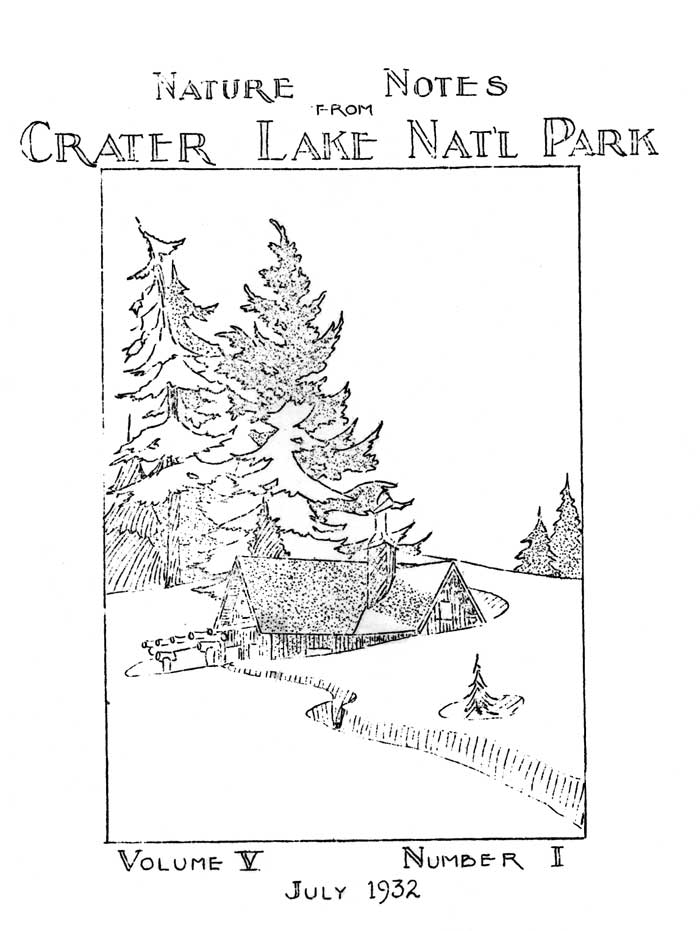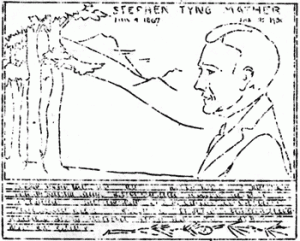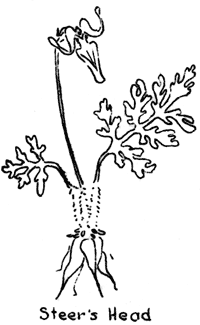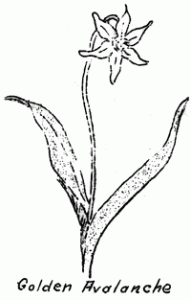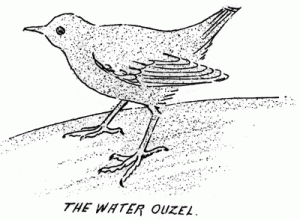Volume 5 No. 1 – July 1, 1932
All material courtesy of the National Park Service. These publications can also be found at http://npshistory.com/
Nature Notes is produced by the National Park Service. © 1932
Greetings for 1932
By D. S. Libbey, Park Naturalist
Again we invite you to come up to Crater Lake National Park and sojourn with us for a time. This year the excessive snow fall of the past winter has made the season unusually late. But now the camp fires are beginning to appear each night on the moraine and the Naturalist programs are in full operation.
To you who have been visitors during past seasons we suggest that you plan your vacation and enjoy the trip or trips you may have omitted previous years. This summer the exhibits along the parapet of the Sinnott Memorial Building are available. It is quite interesting to see the specimens in the display boxes and then to look through the binoculars and actually see the place from which the exhibit material was obtained. Hourly lectures are given by the Ranger-Naturalist. In case you failed to take the Rim Drive last season you will find road conditions more favorable this year. A sunset drive to the foot of the Watchman is added this year.
We wish you would plant to visit us again and enjoy one or all of the following activities:
The hike up Garfield Peak
Afternoon on Crater Lake
Sinnott Memorial Parapet displays – hourly lectures
Rim Drive Auto Caravan
Sunset Drive to foot of the Watchman
Wizard Island Exploration and long lake trip
In this issue we wish to introduce the members of the Research and Educational Staff for 1932.
Mr. Lincoln Constance of last season’s staff is back. He received his M. A. Degree from the University of California last May with major work in the field of botany.
Mr. Earl W. Count of the Zoology Department, San Jose State College is with us at Crater Lake. Mr. Count is a graduate of Williams College, a graduate student in Archeology, University of California and has been on the Naturalist Staff at Grand Canyon for the past three years.
Mr. Edward L. Clark, an Instructor in Geology, University of Missouri, is beginning his work in a particularly enthusiastic manner. Mr. Clark has his M. A. Degree from the University of Iowa and nearly two years additional graduate training at the University of Missouri.
Our host at the Community House of previous years, Mr. Ray Henderson, is back again. You will recall his delightful programs characterized by song, story, informative talks and attractive moving pictures.
It is with pleasure we present our staff for this season. May we have the opportunity to serve you.
Program of Stephen T. Mather Plaque Dedication
By D. S. Libbey
PRESENTATION AND ACCEPTANCE
of the
STEPHEN T. MATHER PLAQUE
Crater Lake National Park
July 4, 1932 2:25 P. M.
| Introductory remarks: | Park Naturalist D. S. Libbey |
| Solo: | “Hills of Home” by Miss Agnes Petzold with violin obligate accompaniment |
| Invocation: | Rev. W. R. Baird, First Christian Church, Medford, Oregon |
| Song: | “The Land of the Empire Builder” by Trio composed of: Miss Agnes Petzold Miss Margaret Hammerbacker Miss Lucile Cummings |
| Address and Presentation of The Stephen T. Mather Plaque: | |
| Judge Robert W. Sawyer, Bend, Oregon Member of the National Committee, The Stephen T. Mather Appreciation |
|
| Acceptance of The Mather Memorial Plaque: | |
| Mr. Elbert C. Solinsky, Superintendent, Crater Lake National Park and member The Stephen T. Mather Appreciation |
|
| Song: | “America” by the Trio and Audience |
The Bronze Memorial Tablet was placed in the Information Bureau on the Rim to commemorate Stephen T. Mather, organizer and first Director of the National Park Service. It is the gift of The Stephen T. Mather Appreciation, Washington, D. C., and association of friends and admirers of Mr. Mather. The plaque was placed in the Information Bureau awaiting such a time when an installation may be made on a suitable boulder which shall be placed adjacent to The Mather Tree. Snow conditions prevented the installation now.
Presentation of Stephen T. Mather Plaque
By Judge Robert W. Sawyer
An extract from his Presentation Address is as follows:
“Upon Mr. Mather’s death last year friends associated themselves in the Stephen T. Mather Appreciation for the purpose of creating a suitable memorial to him. The one finally chosen is in the form of a plaque bearing as its inscription the words of the Honorable Louis C. Cramton regarding Mr. Mather. One of these plaques is today being presented and dedicated in each of the national parks – themselves a memorial to our departed friend, a great citizen and a devoted public servant.
“As a member of the national committee, the Stephen T. Mather Appreciation and on its behalf it is my honor and privilege to present this plaque to Crater Lake National Park to be set up here as a perpetual memorial to Stephen T. Mather. In the words of in inscription, ‘He laid the foundation of the National Park Service, defining and establishing the policy which its areas shall be developed and conserved unimpaired for future generations. There will never come an end to the good that he has done.'”
Address of Acceptance
By E. C. Solinksy, Superintendent
Those of us who know Mr. Mather and had the privilege of working with him in the National Park movement feel that this occasion is altogether appropriate. Our presence and services here today are but proper tribute. The debt the American people owe to Mr. Mather can never be repaid. His was the vision that saw the possibilities of setting aside certain areas for national parks and monuments, the object being, in the first place, to preserve the areas that offered superlative and unique phenomena from wanton waste, and then to create the use of such areas of beautiful natural scenery as instruments for inculcating good citizenship.
Mr. Mather engaged in strengthening the Park Service from every angle. He realized that although the first step in the development must be a program of conservation, the second stage would be the utilization of the parks by the American people for recreational purposes. The vision of Mr. Mather is beginning to bear fruit. Today we find the program to be extended in scope with additional emphasis being placed on our parks as areas for instruction and inspiration.
It is altogether fitting that The Mather Appreciation should place in the representative parks and monuments these plaques. May their presence be a fitting record of the accomplishments of a great man, a man who lead a life of service to the people of his nation. The Stephen T. Mather Plaque is accepted with deep appreciation. May its presence remind all who come and read its message of the prophetic judgment and works of a good man and of a life well spent. May his life and the record he left be an incentive to our citizenship to carry on the great work which he inaugurated. We of Crater Lake National Park will keep and treasure this plaque not only as a monument to a great American citizen, but also as a challenge and inspiration to us for all times to come.
William Gladstone Steel Collections of Photographs
By D. S. Libbey
Another reason for visiting the Information Bureau along the Rim is to view Judge William G. Steel’s collection of photographs. The group consists of thirty-six photographs and included in the collection are pictures of most of the people that have been identified with the discovery, establishment and development of Crater Lake National Park.
For example: Among those included are John Wesley Hillman, The Discoverer, Honorable Theodore Roosevelt, The President under whom the park status was established, Joseph T. Diller, The Geologist who did such extensive research study concerning the geological history of Crater Lake and the group of former Superintendents of Crater Lake National Park. Photographs of many others closely identified with the park are included in the group, of course the large one of Judge Steel still has its place over the mantle.
Pay us a visit at the Information Bureau, these photographs add to the story of Crater Lake. We extend to Judge William G. Steel sincere appreciation for the privilege of exhibiting the collection.
Crater Lake Winter
By Permanent Ranger C H. Simson
During the month of last October when Venus was first covered with storm clouds of the season and announcing the end of a perfect summer, soft fluffy snow flakes gave a general impression that winter was here. This caused the cessation of all park activities and a general preparation of the long winter months to follow. With this storm a snow fall of 36″ was registered. While to some of us it seemed to be a heavy storm, little did we know what the ensuing six months held in store for us.
Following this storm was a period of Indian summer, perfect in every respect, which allowed sufficient time for winter preparations. November was too soon to visit us with her grey overcast skies and occasional snow. However, these early months were busy ones and time went by quickly we hardly noticed the snow gradually growing in depth after each storm. At the end of November the snow fall registered 12′ 3″. With this we found additional tasks to perform and time sped on.
December was still more liberal and revealed a snowfall of 11′ 9-1/2″ giving a total of 24′ .5″. The snow fall for October, November, and December was only three feet below the whole season’s snow fall of the previous year.
January found us in a turmoil endeavoring to remove the snow from the roads and to keep the necessary building open. Spending the night out in blizzards, blasting our way through huge drifts and snow slides to make way for the snow plows became common, and the banner month of the season soon passed, adding 15′ 1/2″ to our total. We became so used to great depths of snow that to pass around the summer cottages and see nothing but mounds of snow or a part of an upper window barely showing did not greatly impress us.
February was more quiet and tranquil but cold as the alcohol dropped to 10 below zero. Continued low temperatures modified storm conditions so that we had but 5′ 9″ of snow fall in February. However, it was late in the month we learned that all buildings would have to be cleared of snow and with many completely buried this was quite a task.
March was all March is supposed to be, storming most of the time and the 9′ 2″ snow fall for this month gave a total of 54′ to date which was twice the amount of the previous year.
April followed promising beautiful weather, but surprised us with 7′ 7″ of more snow. Poor May struggled through with only 3′ 2″ making a total snowfall for the winter of 64′ 9″ the heaviest of record at Crater Lake.
Notes on Flowers
A most peculiar flower, which one may chance to see is the Steer’s Head (Dicentra uniflora Kell.) is now poking up its grotesque blossoms from the pumice slopes of Dutton Cliff and Applegate Peak. Its feathery green leaves, cut up into fine segments, offer a striking contrast to the flesh-colored blooms. It is very closely related to the common Wild Bleeding-hear or Dutchman’s Breeches(Dicentra formosa (Andr.) DC) which may be seen in moist places along the main roads.
Sun Meadows, situated in the glacial valley between Dutton Cliff and Applegate Peak, possesses one of the most beautiful displays of alpine flowers to be found in the Park. But now the snow still effectually delays any very luxuriant growth. However, there is one flower in bloom which is well worth taking trouble to see. This is the Yellow-flowered Lamb’s Tongue, or Dogtooth-violet,(Erythronium citrinum Wats. Parviflorum) which might better be called “Golden Avalanche Lily”, since it is a blood brother of the white Avalanche Lily of Mount Rainier. Each stem arises from a deep-seated, oval bulb, and bears a pair of dark green, lanceolate leaves and a single large golden flower. These hardy lilies spring up on every newly-exposed place, so that with retreating snow seems to leave its foot-prints in green and gold.
Many interested visitors inquire about the identity of the white-flowered, sweet-scented shrub that lines the main road into the park at lower elevations. It possesses broad, shiny leaves, which are mucilaginous on their lower surfaces. This plant has a bewildering variety of local and general common names: Deer-brush, Snow-brush, and Oregon Chapparral (Ceanothus valutinusDougl.) and is closely allied to the Mountain Lilac, or Blue-blossom, although neither are in any way related to the true Lilac, unless in outward appearance.
Along the trail to Garfield Peak, the trailside is blue from the wealth of flowers produced by the Mahalamata(Ceanothus prostratus Benth.). This is a prostrate shrub, with leaves resembling those of holly, which produces great masses of small blue or lilac flowers.
Crater Lake Dogwood
By D. S. Libbey
Last fall the Dogwood trees along the highway approaches to Crater Lake were in bloom. Again as we came up about the middle of June we found the Dogwood in blossom. Often the question is asked, why call a tree such a homely name? This is the explanation given by the Pennsylvania Department of Forests: “A very astringent concoction used to be stripped from the Dogwood and used to wash mangy dogs. That is how the tree got its name. The bark of the flowering Dogwood yields quinine.”
The Water Ouzel
By Permanent Ranger Don C. Fisher
Did you ever walk along a stream and see a bird resembling a thrush or blue bird balance for a moment on some rock then slip headlong into the water only to reappear a moment later, climb back to its perch and with a shrill chatter flit over to some other stone.
This bird is the Dipper or Water Ouzel and is perhaps the strangest bird of our park. Without web feet or any other special adaptation, this little fellow has selected the creeks as his place of abode and finds his food among the rocks in the shallow portions of the stream. When it is feeding under the water the bird will walk along the bottom using its wing to assist in the progress.
In color the Ouzel is slate gray and the stout chunky shape of the bird along with its custom of dipping distinguishes it from any other bird in the park.
The nest is made of a great quantity of moss and it usually found under some water fall or upon the face of some slick rock where it is almost impossible for anything to reach it.
The bird possesses a strong sweet song made up of a great variety of trills and flute-like notes which is delivered with all of the vim that the little fellow possesses.
Recently one of the visitors in the park was fly casting in Sun Creek. Seeing a likely looking pool he decided to try a cast. Whipping the fly to the proper spot he allowed it to float under the old mossy log across the lower end of the pool and soon a tug at his line announced a strike and he was greatly astonished when he drew up his line and found his catch to be an ouzel.
Crater Lake
By Belle Meyer
(Seven thousand feet high in the Cascade Mountains of Southern Oregon, Mt. Mazama, an extinct volcano and monarch of all the range, collapsed. A beautiful lake of indigo blue now lies within it crater. To the scientist, “A mighty volcano collapsed within itself”. To the poet, “A sea of sapphire blue. The sea of silence.”
CRATER LAKESo still, so peaceful, placid-blue,
Guarding a monarch’s grave from view;
No sound but breathless silence — deep,
Nor rippling waves disturb his sleep,
Mazama’s gone! but in his wake,
A lovely jewelled sapphire lake,
Born of chaos, fire and smoke,
Turbulent nature didst invoke
Mazama’s fall — that thou shouldst be —
Silent, mysterious sapphire sea.
Other pages in this section


